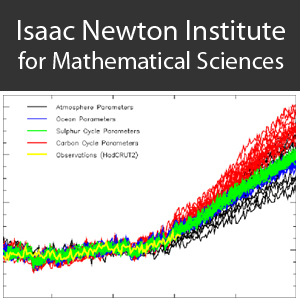Climate entropy production based on AOGCM diagnostics
Duration: 1 hour 3 mins 38 secs
Share this media item:
Embed this media item:
Embed this media item:
About this item

| Description: |
Gregory, J (University of Reading)
Thursday 26 August 2010, 14:00-15:00 |
|---|
| Created: | 2010-08-26 17:28 | ||||
|---|---|---|---|---|---|
| Collection: | Mathematical and Statistical Approaches to Climate Modelling and Prediction | ||||
| Publisher: | Isaac Newton Institute | ||||
| Copyright: | Gregory, J | ||||
| Language: | eng (English) | ||||
| Credits: |
|
||||
| Abstract: | Most investigations of the MEP hypothesis have used climate models which do not explicitly simulate the physics and dynamics of the climate system (such as Paltridge's model), or in which they are radically simplified (such as a dry GCM). We have instead concentrated on entropy analysis of the HadCM3 atmosphere-ocean general circulation model (AOGCM), the kind of model used for prediction of 21st-century global climate change. In the AOGCM, we diagnose the entropy sources and sinks directly from the diabatic heating terms. The rate of material entropy production of the climate system (i.e. not including thermal equilibration of radiation) is about 50 mW m-2 K-1. The largest part of the material EP (about 38 mW m-2 K-1), is due to sensible and latent heat transport. When we vary parameters in the physical formulation of the AOGCM, MEP might suggest that the most realistic version is the one with the largest EP. However, in the AOGCM there is no maximum in EP, for two reasons. First, the strongest influence on EP is the throughput of energy from the net shortwave absorption, which is very sensitive to model parametrisation, rather than the anticorrelation of heat flux and temperature gradient seen in simple models when net shortwave absorption is fixed. This dependence comes particularly from the dominance of EP by the hydrological cycle, which intensifies monotonically with the global average temperature. Second, the EP predominantly comes from vertical heat transport, and to achieve a maximum with fixed shortwave heating implies an unrealistic vertical temperature gradient and/or unphysical longwave emissivity. There is, however, a maximum in KE dissipation in the atmosphere, similar to Lorenz's (1960) conjecture, associated with a smaller part of the material EP (about 13 mW m-2 K-1). |
|---|---|
Available Formats
| Format | Quality | Bitrate | Size | |||
|---|---|---|---|---|---|---|
| MPEG-4 Video | 640x360 | 1.84 Mbits/sec | 881.76 MB | View | Download | |
| WebM | 640x360 | 2.05 Mbits/sec | 971.20 MB | View | Download | |
| Flash Video | 484x272 | 573.48 kbits/sec | 267.56 MB | View | Download | |
| iPod Video | 480x270 | 510.99 kbits/sec | 238.40 MB | View | Download | |
| MP3 | 44100 Hz | 125.03 kbits/sec | 58.14 MB | Listen | Download | |
| Auto * | (Allows browser to choose a format it supports) | |||||

